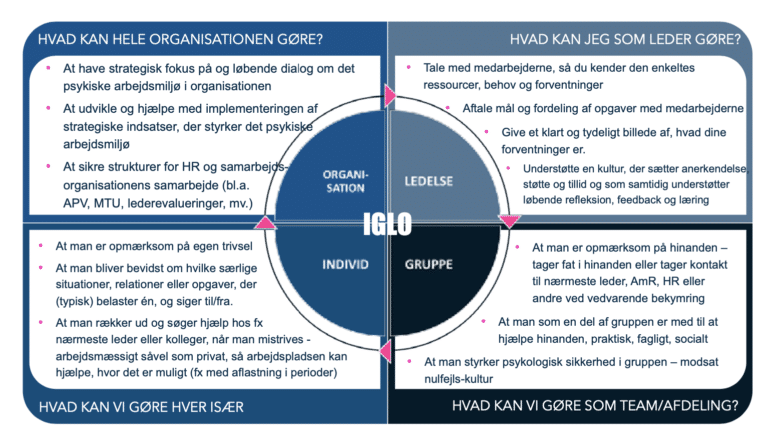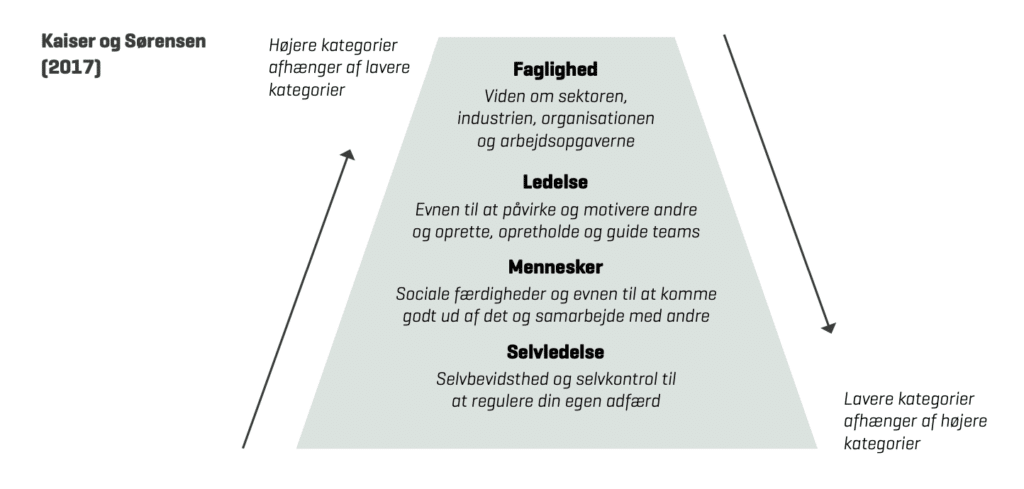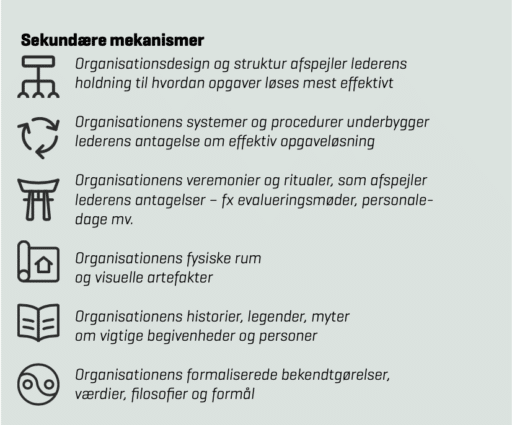When we managers enter the workplace, we also enter a number of areas of tension that greatly affect our task performance and our psychological work environment. As a manager, you must simultaneously deliver on productivity, efficiency and quality based on a number of set goals, benchmarks and strategic initiatives, and contribute to the motivation, attachment, development and retention of the people you manage. This tension can create a high level of emotional pressure that puts us to the test.
The article is published in 'Klædt på til Ledelse', FOA - nye strømninger i Offentlig ledelse 2022.
Most managers will recognize the intersection of conflicting demands that arise in the wake of being responsible for both well-being and performance in the workplace. An intersection that creates tension in the individual and in relationships. Amajor study from BFA (Branchefællesskab for Arbejdsmiljø) paints a clear picture of the tension between , on theone hand, succeeding in creating the best possibleresults through others and, on the other hand, managing the human and relational aspects of collaboration (ofentligledelse.dk/ledere-er-ikke-superhelte).
The task of managing the psychological work environment is complex, and it's not uncommon to meet managers who feel powerless or doubtful. When well-being is high and the atmosphere is good, it may seem like the easiest thing in the world to manage the psychological work environment, but when dissatisfaction, conflicts, stress or abusive behavior arise, it becomes clear how difficult it is to take exactly the 'right' actions. Emotions, subjective experiences, assumptions and individual values come into play, and it becomes difficult to keep track of what's up and what's down.
This leads to a number of paradoxes that cannot be solved once and for all. The challenges as we see them fall into 2 categories - see next section.
"When well-being is high and the atmosphere is good, it may seem like the easiest thing in the world to manage the psychological work environment, but when dissatisfaction, conflicts, stress or abusivebehavior arise,it becomes clear how difficult it is to take exactly the 'right' measures."
The first is in the form of a pitfall that we often see managers fall into. Namely, the notion that it rests exclusively on the manager's shoulders to deliver well-being and a good psychological work environment to employees. Taking on full responsibility creates a breeding ground for a feeling of loneliness in the managerial job - which the Leadership Commission also pointed out that it is common among managers to feel 'alone at home' in the workplace.
The other is too narrow a focus on the effects of the manager's own behavior on the work community. Are you a good role model for the psychological work environment you want? Are the values you base your leadership on reflected in the way you lead?
There are no easy answers, but here are 3 steps you can take to strengthen your mental health management.
You're not alone - seek support and play well together
The BFA study highlights supportive relationships as crucial to leaders' ability to manage the tensions. Unfortunately, the notion that you have to be able to do it all yourself prevents you from seeking and receiving that support. So when you hear that little voice in your head urging you to 'Woman up! These are the conditions. You have to be able to handle it!", remind yourself that the psychological work environment is a joint task and that management is a team sport. In other words: Less 'one-man band' and more 'big band'.
Being able to develop and maintain good and supportive relationships throughout the workplace is absolutely crucial for the ability to take care of your own wellbeing and the wellbeing of others. So the first step to strengthening the psychological work environment is: Insist on an ongoing dialog about what's important so that you can play well together. This applies both upwards and sideways in the management chains, but of course also downwards, not least in the interaction with elected representatives. Examples of questions that these dialogues can be based on are:
Up the management chain, with your immediate manager:
- What developmental, professional and operational focus areas do you need to succeed with in the coming period?
- What goals and success criteria should you have in mind?
- What expectations are there for you to succeed in your role?
- What does that call for from you in terms of leadership?
- Where are you well on your way?
- Where are the key challenges that need to be addressed?
- How can your boss or colleagues in the management team support and inspire you to succeed with the challenges that come your way. How can your manager, peers and internal/external sparring partners provide the support and help you need? How can your manager, peers and internal/external sparring partners provide the support and help you need?
To the side of the management chain, both the local management group and the larger group of peers across the organization are both communities for you; communities that are best served by the qualities of trust, psychologicalsafety and the collective capacity toconstructively engage witheach other.This can be facilitated by dialog based on these questions:
"Being able to develop and maintain good and supportive relationships across the board is absolutely crucial to the ability to take care of your own wellbeing and the wellbeing of others."
How can we as a leadership group and team start sharing both dilemmas and experiences about leadership with each other, so that we can help and support each other and grow as leaders?
How do we make it safe to share our mistakes, insecurities, vulnerabilities and all the things that make us uncomfortable in our leadership role?
How can our own manager support us as a group to ensure we have high psychological safety and a strong learning culture?
Downwards towards elected representatives and the employee group. Of course, the same principle of being in it together applies here. The goal here is to create a sense of alliance and team spirit - which always starts with talking about 'we' and 'our'. Good questions to start the dialog can be:
What could be possible risk factors in our work environment and how do we mitigate them. And vice versa: What could be positive factors in our work environment and how do we strengthen them? In other words, to facilitate the joint discussion of how we together take care of the way we contribute to each other's well-being.

IGLO - a model for shared responsibility
The second initiative to strengthen the psychological work environment is about creating an ongoing systematic and persistent focus on how you, together with your immediate manager and the special functions/representatives in the workplace, work with the psychological work environment. A good way to structure this work can be found in the now widely known IGLO model, developed by the National Research Center for the Working Environment. The model illustrates the 4 organizational levels that all share responsibility for the ongoing work with the psychological work environment: The individual level, the group level, the management level and the organizational level.
The message behind the IGLO model is that none of the 4 levels can succeed alone. They are mutually dependent on each other to succeed. Successful development of the psychological work environment is best achieved if efforts are supported at all 4 levels. If you as a manager are to have a chance of doing your part of the work, it is therefore necessary that
the individual employee, the individual department and senior management are also involved and bear their share of responsibility for contributing to a good psychological work environment.
The arrow is also pointing to you - so take the role model with you
The third and final initiative is based on the premise that, yes, management is a team sport and mental health and safety is a shared task - but as a personnel manager, the arrow points to you first. Whether you like it or not, as a manager you are a culture carrier and creator.
Employees look at their manager's priorities,values and behaviors, and through this they are guided in the way they interact with each other. We will highlight 2 things you as a manager can do to act as a role model for a good psychological work environment.
Know yourself and your impact on the psychological work environment
To navigate these tensions, you need to work on your personal leadership. This means getting to know yourself - both your leadership strengths and your pitfalls in the form of blind spots and unconscious preferences. Otherwise, it will be too difficult to find your footing and stand firm in the field of tension, and you won't be able to regulate the signals you send out. A good model of the hierarchy of leadership skills that shows the connection between the ability to read the needs of the outside world while reflecting on your own values, strengths and pitfalls is developed by Kaiser and Sørensen (2017).
Working on your personal leadership requires a fundamental curiosity and reflexivity about the values you base your leadership on. And whether these values are expressed in the ways you want them to be. The key to this is to work systematically to seek feedback and responses from colleagues to help you see yourself from the outside.
Manage your workplace culture
As a leader, you're constantly transmitting cultural cues. It's not something you choose to do or not to do.
Therefore, be aware of your status as a role model, also in relation to the psychological work environment, and embrace your leadership role in building a healthy, open workplace culture where both the manager and employees dare to be curious and vulnerable together.
This strengthens both learning and the psychological work environment.

"Collaboration and a good ongoing dialog with management colleagues, employees and bosses are among the most important factors for having a good psychological work environment for yourself as a manager."
Culture is expressed in the embedded norms, routines and habits we navigate; in short, the way we do things around here. Culture emerges and evolves over time as people work together, and changing it is no easy task .
One place to start is with organizationalcultural theorist Edgar Schein, who has listed a seriesof so-called 'managerial cultural embeddednessnisms'. This is psychological language for a variety of ways to influence employees' understanding of how workplace culture comes to life through managerial behavior. Schein also lists a number of secondary embedding mechanisms that, if consistent with the leader's primary embedding mechanisms, can support the leader's work in managing workplace culture.
It's easy to get long-winded - but one concrete way to use Schein's list is as a reflection tool to examine whether your leadership behavior is in line with the other cultural markers in the organization. And whether it contributes to shaping a culture that supports both task and result creation and a healthy psychological work environment with adequate learning, psychological safety and development.
Managing the psychological work environment is multifaceted work that calls for a broad-spectrum approach: knowing yourself, managing the culture and being able to give and receive feedback are three of the areas we see as having the greatest impact .
The task of establishing a good psychological working environment is a shared task - a task where a whole system of levels must come into play in order to succeed in a meaningful and visible way. Collaboration and a ongoing dialog with management colleagues, employees andemployees and bosses are among the most important factors for having a good psychological work environment for yourself as a manager.
At the same time, it is a prerequisite for you to take your share of responsibility for your psychological work environment.







